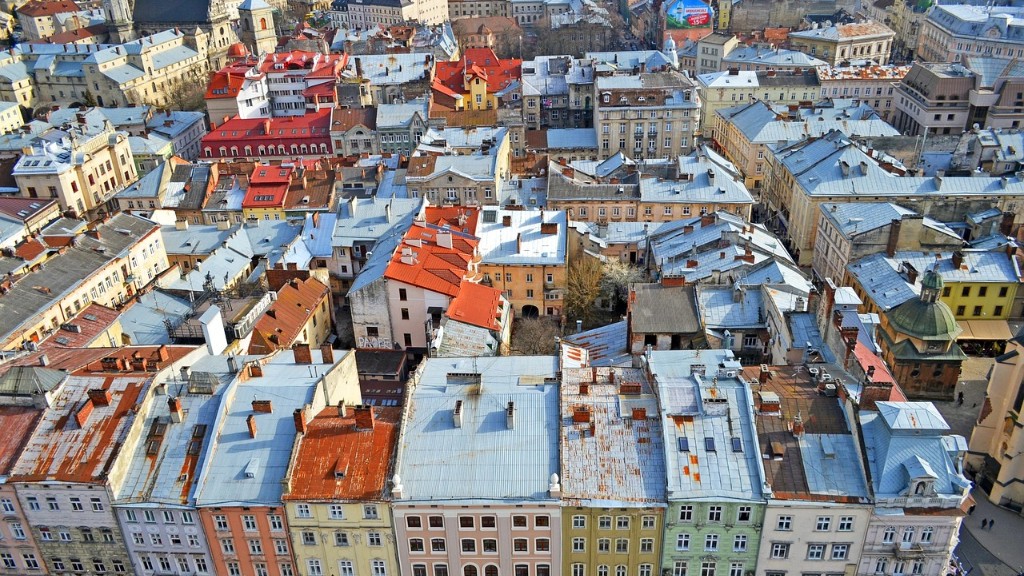As the battle for Ukraine rages on, the extent of destruction and devastation has been revealed. Ukraine has been rattled by war since 2014, when pro-Russia rebels launched an offensive against the pro-Western Ukrainian government. The four-year conflict has resulted in a years-long humanitarian crisis and a nation of destruction; but what percentage of Ukraine has been destroyed?
According to Somea Fasih, a senior policy specialist at the United Nations, more than 10,000 people have been killed in the conflict, including more than 2,000 children. Furthermore, estimates shows that over nine million Ukrainians have been affected at some level by the fighting. This includes roughly 1.5 million people internally displaced within the country and over 1 million people who have had to flee the country altogether. Most of the destruction is concentrated in two eastern regions – Donetsk and Lugansk – which make up around 5 percent of the country’s total landmass. In these regions, much of the destruction has been to homes and infrastructure.
Experts believe that more than 5,000 buildings have been flattened in insurgent-controlled Donetsk and Lugansk, in addition to the loss of electricity, clean water, and other basic services. Furthermore, the destruction of homes and infrastructure has been accompanied by significant economic losses. The conflict has cost Ukraine an estimated $1.14 trillion and reduced GDP growth by 5 percent in 2013.
To make matters worse, there is no end in sight to the Ukraine conflict. The ceasefire between Ukrainian armed forces and separatists was signed in Minsk in 2015, yet the hostilities continue. This has done little to improve the lives of those affected by the destruction. Over 3.4 million people, including 660,000 children, remain at risk in the contact line.
In response to the conflict, the United Nations has launched the Ukraine Humanitarian Response Plan, which aims to provide essential aid and support to those most in need. In addition, the United Nations has also been working closely with the international community to ensure that those affected by the conflict are provided with adequate protection.
As the conflict rages on, it is difficult to pinpoint the exact percentage of Ukraine that has been destroyed. What is clear, however, is that thousands of people have been affected by the violence and destruction, and that the future of Ukraine is uncertain.
The Damage to Ukraine’s Economy
The conflict has exacted a heavy toll on the Ukrainian economy. The country’s GDP had already been in decline due to economic mismanagement and a decrease in global demand for Ukraine’s exports prior to the conflict. Since 2014, the country’s economic situation has deteriorated further due to the disruption caused by the fighting.
The conflict has caused a severe disruption to trade between Ukraine and Russia, one of Ukraine’s key trading partners. Businesses located in Donetsk and Lugansk have been especially hard-hit, as they have been cut off from the government’s support mechanisms. As a result, many businesses in eastern Ukraine have been forced to close, leading to significant unemployment and a decrease in private investment at an already fragile time.
The conflict has also resulted in an exodus of talent from Ukraine. Many skilled workers, entrepreneurs, and innovators have chosen to seek opportunities elsewhere due to the conflict, leading to a shortage of talent in the country. This outflow of talent has made it more difficult for families to make ends meet, and has contributed to a widening wealth gap across the country.
The conflict has also had a negative effect on Ukraine’s public finances. The government’s budget deficit reached a historical high of 8.4 percent in 2015, due in part to increased military expenditure. This means that the government has had to scale back spending on social services, leading to a reduction in public services such as healthcare and education.
The Impact on Livestock and Agriculture
The conflict has had a detrimental effect on Ukraine’s livestock and agricultural sector. A significant amount of farmland has been damaged or destroyed by the fighting, leading to decreased production and an increase in food insecurity. This has been especially true in the country’s eastern region, where most of the fighting has taken place. As a result, hundreds of thousands of Ukrainians have been left without access to safe and nutritious food.
The conflict has also led to a decrease in the production of agricultural machinery in Ukraine. Many of the factories that produce agricultural equipment have been damaged or destroyed, leading to a shortage of farm equipment and an increase in prices. This is particularly problematic for farmers in eastern Ukraine, which is already facing a shortage of agricultural goods due to the conflict.
The destruction of crops and farmland has also had a negative effect on the livelihoods of Ukrainian farmers. As crops have been damaged or destroyed, farmers have had to rely on government subsidies and humanitarian aid to stay afloat. This has had a ripple effect throughout the Ukrainian economy, as farmers have seen a decrease in their income and have been forced to reduce their spending.
Moreover, the conflict has resulted in a decrease in seed exports from Ukraine. As the conflict has dragged on, the production of seeds has decreased and the number of companies exporting seeds has dwindled. This has had a negative impact on the global agricultural market, as the seed trade from Ukraine used to account for around 40 percent of global food crop seed exports.
Environmental Impact
The conflict has also had a severe environmental impact. Ukraine’s wetlands and grasslands have been particularly hard hit, as the fighting has caused large amounts of soil erosion and pollution. In addition, oil fields in eastern Ukraine have been damaged, leading to increased air pollution and contamination of soil and water sources.
The destruction of forests in eastern Ukraine has also had a negative effect on the environment. Thousands of hectares of woodlands have been destroyed, leading to a loss of biodiversity and a decrease in the area’s carbon sequestration capacity. Furthermore, the disruptions caused by the conflict have led to an increase in illegal logging and poaching, further exacerbating the environmental damage.
The conflict has also had a devastating effect on Ukraine’s fisheries. The destruction of fishing infrastructure has made it difficult for fishermen to make a living, as they are forced to compete with increasingly scarce natural resources. In addition, the use of contaminated water sources for fishing has caused a decrease in the overall fish population and an increase in the levels of toxic chemicals in fish.
International Aid
In order to mitigate the effects of the conflict, the international community has stepped in to provide aid and support to those affected by the destruction. The European Union and United States have provided over $3 billion in humanitarian aid, while other countries such as Canada and Japan have also pitched in with financial contributions.
Moreover, the International Red Cross and other humanitarian organizations have been providing vital services, such as shelter and healthcare, to those affected by the conflict. These organizations have also been instrumental in providing food assistance to internally displaced persons and those living in poverty.
The international community has also taken steps to ensure that trade is not disrupted by the conflict. Organizations such as the World Trade Organization (WTO) have been instrumental in negotiating a number of trade agreements between Ukraine and its trading partners. This has enabled the country to continue exporting goods, thus helping to alleviate the economic hardship brought about by the conflict.
Finally, the international community has also provided financial and technical support to the Ukrainian government in order to help the country rebuild and recover. This includes support for the reconstruction of infrastructure, the strengthening of government institutions, and the provision of loans and grants to help business owners and entrepreneurs.
The Human Toll
Despite efforts to aid the population affected by the conflict and reconstruct the damaged infrastructure, the human toll of the conflict remains high. Thousands have been killed and millions have been displaced, as the conflict shows no sign of ending. Mental health has also been affected by the conflict, as people continue to live in fear of violence and struggling with the trauma of what they have experienced.
Furthermore, human rights violations have been rampant in Ukraine. International organizations have documented cases of torture, arbitrary detention, and other forms of ill-treatment. This has had a detrimental effect on the mental and physical wellbeing of thousands of people.
The conflict has had a significant gender-specific impact, as women and girls have faced a greater risk of sexual violence. In addition, women and girls have often been targeted for physical violence, with reports of forced marriage and domestic violence. Furthermore, women have faced an increased risk of discrimination in the workplace, as jobs are often linked to the political situation.
Children have also been affected by the conflict, particularly those living in eastern Ukraine. In addition to being the victims of violence and abuse, children are often forced to leave their homes and miss out on education opportunities due to the disruption caused by fighting.
The Aftermath of the Conflict
The conflict in Ukraine has taken a drastic toll on the country and its people. As the fighting continues and the destruction mounts, it is difficult to estimate the exact extent of the damage or the percentage of Ukraine that has been destroyed. What is clear, however, is that thousands of people have been affected by the violence and destruction, and that the future of Ukraine is uncertain.
The international community must do more to help those affected by the conflict and to ensure that the situation does not deteriorate further. In addition, the Ukrainian government must ensure that it is upholding its obligation to protect human rights, and that those who have been affected by the conflict are provided with aid and support.
Ukraine is a resilient nation, and the people of Ukraine have shown determination and courage in the face of adversity. Although the situation remains uncertain, it is possible to restore the country to its former glory and bring peace and stability to the region.





